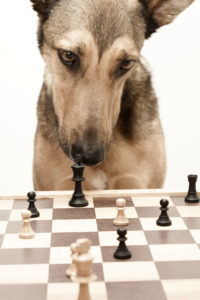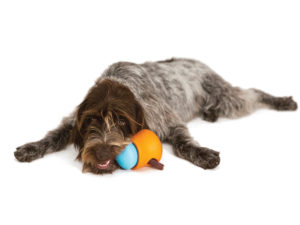 Happy 2020 folks! One of my goals for this year is to diversify our content and make it more widely accessible. I’ll be working on more in-depth and consistent blog posts, and am hoping to branch out to teaching some classes online as well. You should be able to subscribe to be notified when new posts are published by scrolling to the bottom of this one, posting a comment and clicking “Notify me of new posts via email”. – Emma
Happy 2020 folks! One of my goals for this year is to diversify our content and make it more widely accessible. I’ll be working on more in-depth and consistent blog posts, and am hoping to branch out to teaching some classes online as well. You should be able to subscribe to be notified when new posts are published by scrolling to the bottom of this one, posting a comment and clicking “Notify me of new posts via email”. – Emma
What Makes Your Dog Tick?
By Emma Holly, MS, CPDT-KA, CSAT
At Happy Dog Institute (HDI), we love a good training plan just as much as the next person. However, we would be doing a disservice to our clients without ensuring a solid understanding of learning theory and biological influences first. When we understand why our dogs do what they do, we have a much better chance of making changes. In turn, this helps us stay patient, consistent and committed to our goals when working with our beloved animals.
How Dogs Learn
Dogs do what is safe (association) and they do what works (consequence). They don’t have some master plan to take over the universe or even our household, they are just out to get their needs met. They don’t have morals, they don’t know right from wrong (it’s true, we promise!), and they don’t speak any human language fluently (except perhaps reading our body language).
Learning by association.
An example of a dog doing something to make them feel safe is hiding from a person they’ve never met before, or barking at another dog on a walk. They don’t feel safe, and so they deploy a “fight, flight or freeze” response in order to get themselves back to homeostasis. In my opinion, it’s not fair to expect a dog to suppress their behaviors exhibited due to fear responses – but I could get carried away talking about this easily. More about this in another post! The main takeaway here is that we want to be sure we know how a dog feels about something before making steps to changing behavior. We don’t want to skip over that part.
Learning by consequence.
They also do things that work for them, and this is a biggie. Why do dogs bother to jump on people? Because they get attention for it. Or sometimes they do, which basically turns us into glorified slot machines. It’s always worth trying in case they’ll get reinforced this time! (nerd moment: this is called intermitted reinforcement.)
Our dogs are constantly learning from their environment, and whether they get feedback for certain behaviors determines whether they’ll bother repeating it. That feedback can be from other people (i.e. attention, in the case of jumping) or by making something happen environmentally (they pull on the leash and they get to sniff, they bark and the mail carrier runs away – you get the idea).
In general, dogs are just trying to figure out how to get their needs met, and which behaviors (I like to call them “buttons”) work to accomplish this.
Biological Influences
Breeds, drive, temperament and genetics.
Everything is a combination of environmental factors and genetics. We are seeing more and more “working” dogs in household contexts, too. When these dogs don’t get enough mental and physical stimulation and/or they don’t have the job they were bred for, behavioral problems abound. We see an increase in stereotypies (which are behaviors that don’t serve a biological purpose and are often a result of boredom). We also see an increase in unwanted attention getting behaviors, barking, destruction – you name it. Identifying and addressing what our dogs need from a biological perspective is essential for their welfare and success of any behavior changes we are hoping to make.
A dog’s “drive” to do what they are bred for, as well as their individual temperament and inherited genetics, has a huge influence on their propensity to offer certain behaviors. It also largely determines the amount of energy they need to expend to stay physically and mentally tired.
Physical & mental exercise.
We’ve all heard the saying that “a tired dog is a well-behaved dog”, and it’s a saying for a reason. Now that we understand what might be motivating our dogs, setting aside any medical issues (if you’re not sure, check with your vet), we need to make sure our dogs are getting enough physical and mental exercise. Animals need to move and they need to use their brains. They also rely on a lot of time with us, which should go without saying! Making sure these basic needs are being met is essential to their welfare.
At HDI, we are fairly obsessed with Sarah Stremming’s “Decompression Walks” as an alternative to neighborhood leash walks. Cardio is also really important, which you can accomplish by teaching fetch, taking your dog swimming, facilitating playtime with a dog friend of theirs – if they like other dogs! – playing tug of war, etc. We aren’t going to be successful in influencing behaviors when our dog is too wired to think straight or relax. We consider short leashed walks to be “social events”. Cardio, decompression walks and mental exercise usually do a better job of ensuring welfare of our dog’s body and mind.
#ditchthefoodbowl
Say what? Biologically speaking, animals aren’t wired to just lay around and be fed from a bowl. We might consider it cruel to make them work for their meals, but it’s actually one of the most humane things we can do for them. In many zoo environments, for example, they offer enrichment toys to the animals who live there. Instead of getting their food in a dish, they are encouraged to “hunt” for their food in toys, trees (think: orangutans making tools to fish bugs out of an artificial log at the Smithsonian Zoo in Washington, DC, or big cats finding their pray up high in trees at the Edinburgh Zoo) and other creative means.
Products We Like
We have a lot of interactive food toys that are on the market, including West Paw’s Toppls. The large are for dogs over 20lbs and their small Toppls are for dogs under 20lbs. We like to use these as KONG alternatives, although we also still really like KONGs! You can also purchase both Toppl sizes and screw them together to make a treat dispenser.
Other go-to toys include StarMark’s Bob-a-Lot, both large and small, as well as KONG’s Wobbler in large and small.
You can make your own to save money. Search online for DIY interactive food toy ideas – they don’t need to be fancy!
We also really like this Biothane Long Lead from a Company in Eugene, Oregon for Decompression Walks (One that’s 15-20 feet long is great).
That’s a wrap! We’d suggest spending the next week starting to categorize your dog’s behavior into two columns: safety (association) and function (consequence). Then, next to each behavior, write down what the trigger might be and/or why your dog is doing the behavior. Next, how can you remedy some of the behaviors with management (avoidance) or some changes in routine?
In our next post, we’ll go over how to teach your dog something new and develop a successful training plan.


